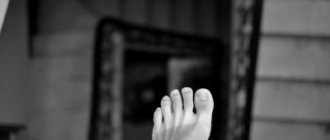Breathing is the most important physiological process. Thanks to it, all vital systems and organs of the human body function normally. Fear of suffocation is a common phobia that occurs in a person just at the thought of the possibility of suffocation. Very often you can meet people who claim: “I am afraid of suffocating.” According to medical terminology, this pathological condition is called anginophobia.
The essence of the problem
Anyone knows that breathing is a vital process. As long as a person breathes, he lives. Without oxygen supply, the nutrition of all internal organs stops and they stop functioning. That is why a person consciously or subconsciously tries to evaluate this process by listening to his own breathing.
Difficulty breathing can be caused by completely objective reasons:
- a real lack of oxygen in rarefied, gassed or polluted air, as well as under water;
- long stay in a confined space;
- physical blocking of the respiratory tract (this phenomenon can be caused by respiratory diseases or foreign bodies entering the respiratory tract).
Many people know how to regulate the process by holding their breath for quite a long time. However, the respiratory center works in automatic mode, so complete cessation of breathing cannot occur simply at the request of a person. For such a pathology, corresponding exogenous or endogenous causes must appear.
Fear of death is a natural human phobia. If there are serious illnesses or extreme external conditions, then such feelings are completely justified. However, often obsessive thoughts have no real basis, but are caused by an abnormal reaction of a neurogenic nature.
Fear of suffocation is a fairly common phobia. The thought “I’m afraid of stopping breathing” becomes obsessive, and the person subconsciously reacts inadequately to the slightest changes in the rhythm of the respiratory system. He becomes especially scared at night and in confined spaces. Naturally, such nervous disorders cannot pass without a trace and over time lead to serious nervous disorders. Among experts, the fear of suffocation is called anginaphobia, combining concepts such as mental deviation (phobia) and respiratory tract disease (angina, which really makes breathing difficult).
Thus, anginophobia is an inadequate reaction of the nervous system when there are no disturbances in the respiratory system and the risk of stopping it. In this case, the person cannot actually suffocate, but there is a possibility of functional impairment in the form of panic disorder. Naturally, this condition should be clearly separated from real danger in the presence of respiratory pathologies (for example, asthma) or extreme external conditions.
Why is it difficult to breathe during a panic attack?
As you know, an attack of PA is provoked by a “loose” sympathetic nervous system. We usually bring it to this state ourselves, with our stress, internal experiences, negative thoughts, but that’s another story. And now closer to the problem of breathing.
Working in a completely abnormal rhythm, the sympathetic part of the nervous system begins to randomly release adrenaline. This is what provokes a rapid heartbeat. Essentially, the body thinks that it is in danger and develops a certain system of reactions that allows a person to “fight or flight.” In a state of high alert, the body needs more oxygen. Therefore, following tachycardia, the brain sends a signal to the lungs about increased ventilation. And tachycardia itself forces the body to breathe more often.
But the VSDeshnik does not rush into a fight and does not run away in order to use up the impulses released by the nervous system. He usually remains in place, and completely plunges into a state of panic. The imagination of the unfortunate man paints the most terrible pictures, which he himself is afraid of. From this fear, the body begins to release even more adrenaline and the situation becomes a vicious circle - the person is afraid because he feels bad, the person feels bad because he is afraid.
In addition, with rapid, shallow breathing, the body does not receive the required amount of carbon dioxide, which is also necessary for the normal functioning of cells. This fact makes the brain think that things are really bad and that it’s over. It (the brain) begins to give even more alarm signals, increasing the panic of the unfortunate person. Fear grows, health worsens.
Why is there a problem?
The phobia in question can occur in any person with increased sensitivity to psychological influences. The reasons are purely individual. In some people they can cause such deviations, while in others they pass completely without a trace.
The following circumstances are identified under which fear of suffocation may be provoked:
- Specifics of the profession. At risk are occupations such as miners, divers, speleologists - when people spend a long time in extreme conditions, and the specifics of the work are sometimes associated with a lack of oxygen. A constant lack of oxygen leads to a subconscious fear of suffocation even under normal conditions.
- Dangerous habits. Anginophobia is quite often recorded in alcoholics, which is associated with the peculiar effect of ethanol on the central nervous system. The most susceptible to this anomaly are substance abusers, especially those who use polymer bags to enhance the effect.
- Extreme entertainment. Some “originals” use short-term strangulation instead of drugs, and sometimes to enhance sexual pleasure. Frequent use of such dubious technologies can lead to certain mental disorders.
- Information background. Recently, in the media, on television, and in films, scenes with elements of “horror” films involving strangulation have become a common occurrence. In addition, a lot of information is provided on diseases of the respiratory system, poor ecology, etc. People with sensitive psyches perceive such information too keenly, and their nervous system is in constant overstrain.
- Painful condition. Some diseases create periodic disturbances in the breathing rhythm (for example, cardiac problems). Although such health problems cannot stop breathing completely, sufferers may experience a fear of suffocation.
- Previous experience. If a person has previously found himself in difficult situations associated with a lack of air, then such experience can contribute to the emergence of a chronic fear of suffocation, even in situations that are not capable of causing it. The beginnings of a phobia can begin in childhood, when acute attacks of sore throat or laryngitis lead to serious breathing problems.
Fear and feeling of lack of air
Anginophobia is a disorder in which a person himself creates the object of his concern with negative emotions. During an attack of fear, the heartbeat increases, the speed of blood flow increases , which needs more oxygen. In this case, a person experiences a feeling of lack of air, which causes a new wave of experiences.
Often the feeling of lack of oxygen provokes an attack of fear, since the person does not know the true cause of difficulty breathing. If you can understand why it became difficult to breathe and eliminate the problem, then the level of anxiety will partially decrease.
What can cause the feeling of difficulty breathing?
- Any physical activity that increases your heart rate. Shortness of breath is a natural reaction of the body to additional physiological stress.
- Uncomfortable clothing that pinches and constricts various parts of the body.
- Body position.
- Pollution, smoke in the room or environment, thin air.
- Weather conditions: high humidity, dryness, changes in atmospheric pressure, etc.
- Any emotion that increases the beating of the heart.
- Prolonged stay in a confined space.
How does the anomaly manifest itself?
The development of anginophobia is associated with the state of the human nervous system and the advanced state of the disease. This phobia can have different manifestations:
- constant fear not associated with any specific circumstances;
- periodic attacks of fear under certain circumstances.
The duration and intensity of mental disorder are individual characteristics.
Conventionally, all symptoms of anginophobia can be divided into 2 categories:
- Physiological and mental disorders. These are called internal signs of the disease.
- External signs that are characterized by certain gestures, movements or facial expressions.
The first group of manifestations is expressed by the following symptoms:
- excessive sweating;
- tachycardia;
- dizziness;
- general weakness;
- nausea;
- bowel dysfunction (most often diarrhea);
- frequent urination.
The nervous system responds in the form of an anxious state, internal fear, reaching horror, nervousness or complete apathy to what is happening; isolation. In the advanced stage of the disease, a person falls into real panic during an attack and is capable of doing unpredictable things.
The characteristic external manifestations of anginophobia include the following symptoms:
- dilated pupils, anxious, tense gaze, “shifty” eyes;
- decreased muscle tone, which causes a syndrome such as “cotton-like” limbs, because they cease to fully function;
- paleness or redness of the skin;
- change in voice timbre, and sometimes loss of voice;
- change in facial expressions;
- trembling of hands, lips.
It should be noted that an intense attack of phobia is very dangerous. In particularly sensitive people, it can cause loss of consciousness, which requires urgent assistance.
Symptoms of phagophobia
Like other phobic disorders, phagophobia manifests itself in a number of somatic and psychological symptoms. However, they can be expressed to varying degrees. With severe phagophobia, a person not only avoids eating solid food, but is also afraid of pictures that depict “potentially dangerous” food.
With phagophobia, when eating food, a person may experience:
- increased heart rate;
- increased sweating;
- lump in the throat, spasm in the throat, great difficulty swallowing;
- inability to take a breath or, on the contrary, increased breathing rhythm;
- headache and dizziness;
- sudden weakness in the muscles (the patient’s legs “give way”);
- tremor of the limbs or the whole body;
- irritability and fussiness;
- derealization and depersonalization, that is, loss of the ability to navigate space and time and loss of a sense of one’s own “I”;
- desire to hide from reality;
- sleep disorder (constant drowsiness or difficulty falling asleep).
Principles of treatment
If a mental disorder acquires signs of illness, then it is necessary to contact a psychotherapist for professional treatment. Doctor's tasks:
- identifying and eliminating the causes of phobia;
- decrease in the intensity of the reaction of the nervous system and the entire body as a whole;
- reducing the frequency of attacks of anginophobia;
- acceleration of recovery after recovery from a panic state.
In general, the psychotherapy technique is based on a two-way process. First, the doctor must establish close contact with the patient to obtain from him complete information about the state of fear. Secondly, it is necessary to convey the necessary information to the patient’s consciousness. The psychotherapist must convince the patient that his fear is unfounded, and also help him control his emotions even under extreme conditions.
To achieve this goal, various methods of influence are used. At the initial stage of treatment, professional assistance can be provided in the following ways:
- individual conversation with explanation of various specific situations;
- issuing recommendations on the behavior of a sick person during an exacerbation;
- conducting trainings simulating various situations.
Effective treatment of anginophobia, as a rule, is provided by a complex method, i.e. by combining psychological sessions with drug therapy.
Medicines are prescribed taking into account the severity of the disease, the intensity of its manifestations and the characteristics of the body. The following groups of funds are distinguished:
- Tricyclic antidepressants. They help normalize the functioning of the entire nervous system and its central apparatus.
- Benzodiazepine drugs. These medications are relatively mild tranquilizers and are designed to reduce the intensity of the attack.
- Beta blockers. Such drugs are prescribed in the presence of cardiac problems that can cause fear of suffocation.
- Psycholeptics. These medications relieve anxiety.
When using such therapy, it must be taken into account that all drugs are considered potent drugs. They can cause an addictive effect. The use of neurological medications is permissible only as prescribed by a doctor.
Causes of phagophobia, fear of choking on food
As a rule, phagophobia occurs after a person has experienced a negative experience, i.e. choked while eating, which caused mechanical suffocation. A panic attack occurs from a strong fear of dying at this moment. The brain perceives the inability to take a full breath as a threat to life. The horror experienced is deposited on a subconscious level. As a result, each meal causes associations with an experienced incident, which leads to the formation of a persistent phobia of choking while eating.
Phagophobia can also be caused by parental fears that the child will choke. The child sees the parent's fear and thereby acquires the attitude that eating is dangerous, you can choke and a disaster will happen. Therefore, even if you have phagophobia, try not to transmit this fear to your child, so as not to infect him with this fear.
If a person suffering from phagophobia does not receive the necessary treatment, he may develop kibophobia, that is, a fear of eating. As a result, the patient may completely refuse to eat, which causes the development of anorexia, which threatens life and health.
If phagophobia is mild, the patient tends to eat food only in liquid form, which makes it impossible to provide the body with all the necessary nutrients.
Due to phagophobia, a person cannot live a full life. The disorder affects not only eating behavior: it leads to limited social contacts. For example, the patient may refuse to go to cafes and restaurants, stop visiting friends, and do not attend family events that involve eating. As a result, a person may be negatively perceived by close people, who begin to consider him closed and uncommunicative. A lot of time and effort is spent planning your own “safe” menu. There are practically no resources left for communication, work and hobbies, which sets the stage for the development of depressive disorder.
With phagophobia, a person realizes the irrationality of his fear and is critical of his own condition. However, this understanding does not allow one to control behavior and cope with the anxiety that arises every time one eats.
Prevention of pathology
Of course, in real life it is impossible to exclude all extreme situations that can cause various phobias. However, we must admit that mental illnesses are caused by excessive psychological and physical stress, poor lifestyle, and bad habits. The nervous system must be brought back to normal in a timely manner. For this you need:
- optimal combination of an active period with proper rest;
- positive emotions;
- normal relationships in the family and at work;
- physical exercise;
- conducting auto-training.
A particularly harmful environment that provokes anginaphobia is the musty air of rarely ventilated rooms. Fresh air is the best disease prevention. Frequent walks in the park, trips to nature, holidays at sea or in the mountains create a good preventive basis for combating the fear of suffocation.
If the work is related to the previously indicated extreme conditions, then only strict adherence to all safety rules creates confidence that suffocation is impossible. Horror films are contraindicated for sensitive people, and it is better to refrain from watching some TV shows. It is more difficult to behave in the presence of chronic respiratory diseases. In this case, timely treatment and obtaining complete information about the possible development of the disease are necessary. A person must be mentally prepared for any development of events, including the occurrence of emergency situations.










